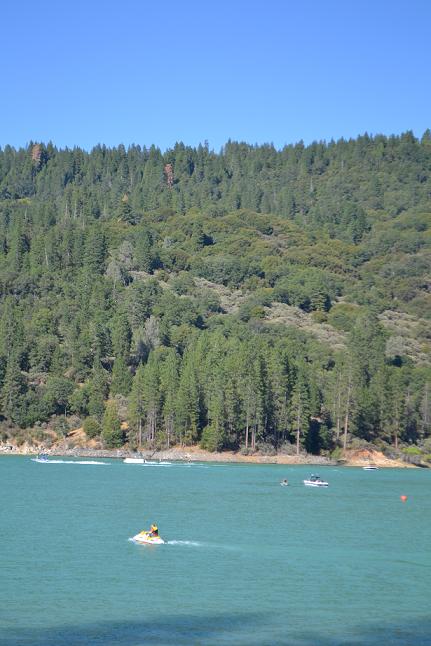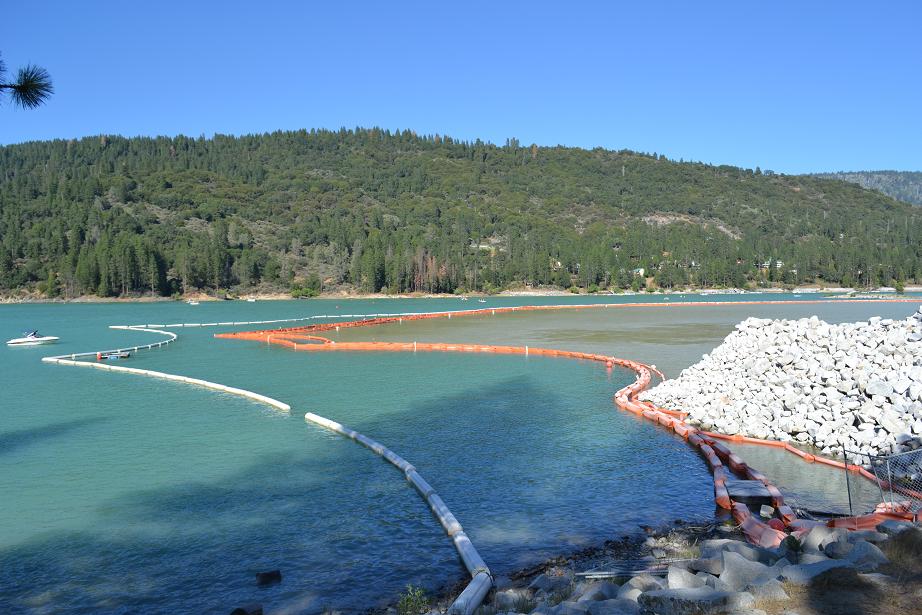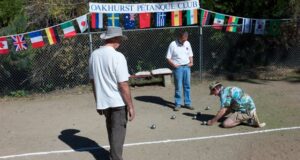Hikers and bikers look forward to the re-opening of the trail across the dam at Bass Lake
“By the first of the year the Crane Valley (Bass Lake) dam should be open for foot and bicycle traffic across the dam,” says Mike Palmer, project engineering supervisor for the Southern Hydro Group for Pacific Gas & Electric (PG&E), owner of the dam. “We’re down to the point now we’re getting ready to start wrapping things up.”
That’s good news for everyone along the lake shore, where for the past several years, low lake levels and closed parking lots and access routes have changed the way we recreate at Bass Lake.
At a Town Hall meeting at the Pines Resort at Bass Lake on Aug. 25, hosted by District 5 Supervisor Tom Wheeler, Palmer updated attendees about the dam retrofit project.
“We’re in the final phases of the project. The remaining activities are to complete the placement of about 15,000 cubic feet of rock and finish raising the dam crest. When we finish those two things we will be able to declare the reservoir operational and restore the pre-project lake level elevations.”
Palmer says they anticipate about another three weeks of moving rock up from the Raymond quarry, and they have begun 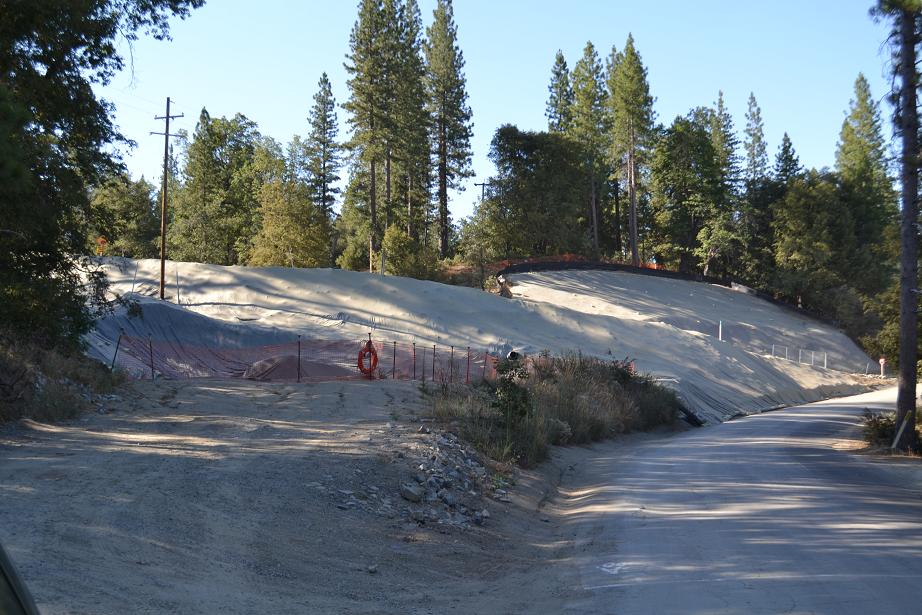
“We’ve been working very closely with the Forest Service to come up with a landscaping plan to put that all back together,” said Palmer. “Crews are out there right now re-contouring the area and replanting it. We’ve got a large part done already; planting native grasses and eventually shrubbery and trees.”
Crews will be establishing an irrigation system a little later this year, and placing wattles (long tubes of straw wrapped in burlap) to prevent erosion as we move into the winter.
“Then we’ve got a couple years ahead of maintaining the area, replacing any vegetation that dies, and insuring that our erosion control measures stay in place,” says Palmer. “We’ll have a pretty heavy presence there through the end of this year, and then we’ll really cut back on the amount of staff we have. We’ll still have an office complex out there through the end of next year while our re-vegetation folks are maintaining the system.”
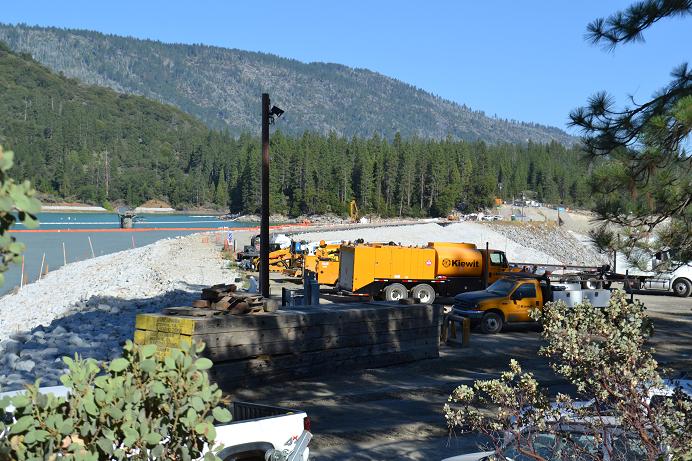
“The parking area will look a bit different, but be about the same size it was before. We’re also working with Madera County to mitigate any impact we had on Road 222 and Road 200 all the way to O’Neals.”
Palmer addressed the issue of turbidity in the lake due to the dredging operations. “We built two silt curtains that run the length of the project that prevent silt from moving out into the main reservoir. Standing out at Marina View near the dam, you can see the color of the material on one side and the color on the other side. It is dramatic. We feel that the silt curtain was very, very effective in keeping the majority of that water from moving out into the main reservoir.”
As to impact on the fishery, Palmer said, “We worked very closely with the California Department of Fish and Game to evaluate how that turbidity was affecting the fishery. Biologists have told me that the turbidity in the reservoir should not have been harmful to fish. Fish could move out of one area to areas where it was less turbid.”
This should be the last winter that lake levels are low. Those very low water levels were necessary for crews to build crane pads on the lake bed, and now that the project is nearing completion, the lake bed will be restored and water levels back to pre-project elevations.
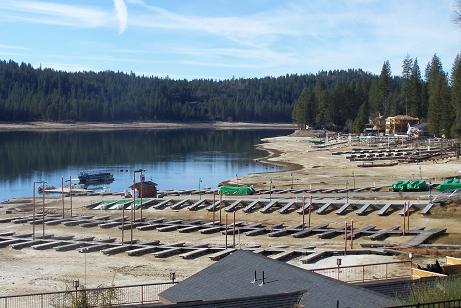
“Crane Valley (Bass Lake) dam was built in 1911. Prior to the construction of the dam, there was a mill pond there. The dam was built as part of the development of a hydro electric project that runs from here down to the San Joaquin River. It was built with a method called ‘hydraulic fill.’
“They went up into the old meadow, and they built a small dam and a wooden flume and diverted the creek into the flume. Basically a bunch of guys with shovels shoveled dirt into the flume which carried the water and dirt down to where the dam was. They built impermeable soil material on the upstream and downstream side and then they just let this material flow into the middle.
“In order to provide a watertight seal, there is a concrete core wall that runs the length and the height of the dam. But that kind of method, you can imagine, without compacted soil, really isn’t the best thing you want to have when you have water impounded behind it. They did however, compact it. They ran goats back and forth across that material after they placed it.
“Those of you who know where Goat Mountain is, just to the west of the dam, may also know the story of how it got its name. The legend is that those goats were let go when their job was done, and lived up there on that mountain until, I guess, the coyotes and mountain lions got them.
“So the dam was built in 1911, and it was 145 feet high. It stores 45,400 acre feet of water behind it. If you look at the dam, you notice that about a third of the way through there a kind of a bulge in it. When they began to fill the reservoir, the center of the dam started moving downstream. That’s not a good thing for a dam. And you notice it is extra thick there.
“What they actually did is they just started dumping more and more rock into that section until it stabilized. Now, that worked in 1911. In the years since, we’ve really improved our understanding of what earthquakes can do to facilities. We’ve done a lot of analysis of this and a couple improvements, but in 2000, we undertook a very detailed analysis of this dam. We felt that what we call the ‘maximum credible earthquake,’ which would be an earthquake on the San Andreas Fault, would cause shaking in this area such that it could potentially destabilize the dam. And if you live in North Fork, that’s not a good thing. So we undertook this project to stabilize it, and the job that we’re doing right now is going to extend the life of this dam 100 years or more.
“We did an economic analysis where we looked at what the cost of the project was, what the alternatives were, and there were only two 2 choices – we either did it or we removed it. It couldn’t be left as it was, and removing the dam would have meant also removing all downstream facilities, including Manzanita Lake and the powerhouses, plus restoring the meadow back to a pre-project condition.
“So, we’ve had great success with this project, we’re in the final phases of the work, and we’re still spending money daily out there. We’re above $100 million right now. It’s a significant infrastructure improvement project for our company.”
Visit the website at http://www.cranevalleydam.com/

